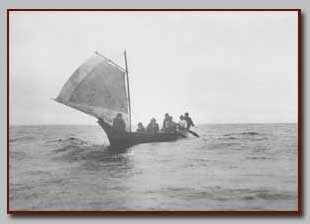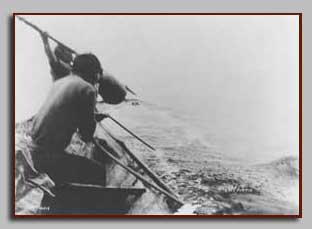Whaling
More than anything else, whale hunting represents the spiritual and technological preparedness of the Makah people and the wealth of the culture.
Whales gave oil, meat, bone, sinew, and gut for storage containers: useful products, though gained at high cost in time and goods. Only families already wealthy could afford such outlay. Only such outlay rewarded with the highest possible prestige. Among the distinguishing marks of this sort of high rank, at least by the historic times, were hats with knobbed tops. Wide brims protected against glare from the water, as with all hats; the knobbed shape of the crown labeled the wearer's high class.
To get ready for a hunt, whalers went off by themselves to pray, fast and bathe ceremonially. Each man had his own place, followed his own ritual, and sought his own power. Weeks or months went into this special preparation, beginning in winter, and whalers devoted their whole lives to spiritual readiness.
 Spring was the time for the hunt. Men waited for favorable weather, then paddled out eight in a canoe, timing arrival on the whaling grounds for daybreak. Their power strong and preparation thorough, they took the great whales.
Spring was the time for the hunt. Men waited for favorable weather, then paddled out eight in a canoe, timing arrival on the whaling grounds for daybreak. Their power strong and preparation thorough, they took the great whales.
This relation between men and the whale is very old: Ozette deposits dating from 2,000 years ago hold humpback and gray whale bones, and barbs from harpoons. The relation is also very recent: Makah people alive today tell of the last whale on the Neah Bay beach, the result of a hunt in the early 1900s. They remember the smell of oil being rendered, and have heard firsthand what it was like to glide in a canoe alongside a free swimming whale and make a kill.
Paddling silently, whalers studied the breathing pattern of their quarry. They knew from experience what to expect. As the whale finished spouting and returned underwater, the leader of the hunt directed his crew to where it would next surface. There the men waited.
 When the whale rose, the paddlers held the canoe just to its left, their speed matched to the animal's. As the back broke the surface, the harpooner struck and the crew instantly paddled backward, putting all possible distance between craft and wounded prey so as to avoid the thrashing tail flukes. Floats of sealskin blown up like huge balloons and attached to the harpoon line also slowed the whale.
When the whale rose, the paddlers held the canoe just to its left, their speed matched to the animal's. As the back broke the surface, the harpooner struck and the crew instantly paddled backward, putting all possible distance between craft and wounded prey so as to avoid the thrashing tail flukes. Floats of sealskin blown up like huge balloons and attached to the harpoon line also slowed the whale.
Harpoons weren't intended to kill whales, but to secure the sealskin floats to them until they tired themselves and could be lanced fatally. Shafts of yew wood measured 13 to 18 feet long: heavy wood to add weight to the harpooner's thrust and help the blade pierce deeply. Splices in the shaft deadened the springiness and furthered the penetration. They also let the shaft break, rather than hit the canoe repeatedly if the whale rolled. Furthermore, they allowed a clean break rather than a splintering. This aided repair.
Shafts fell away once the harpoon head had been set. In the whale, the head turned partly sideways. Barbs of elk antler helped to keep it from pulling out. They fit on each side of the blade, which was mussel shell. Spruce pitch-at Ozette still pungent after 500 years in the within the earth-fared and smoothed the head. Whale sinew plied into rope and bound with bark attached the harpoon head to as much as 40 fathoms of additional rope. This line, which was of twisted cedar boughs, was carried coiled within the baskets so that it would play out easily and wouldn't entangle the canoe's occupants.
 A telltale float at the end of the line acted as a marker so that the whalers could follow their prey, setting additional harpoons and staying out overnight if need be. Eventually the time came for the kill. It was made with a special lance.
A telltale float at the end of the line acted as a marker so that the whalers could follow their prey, setting additional harpoons and staying out overnight if need be. Eventually the time came for the kill. It was made with a special lance.
The next step was to tow the whale home-a distance of only a few miles if its spirit had heeded prayers to swim for the beach, perhaps ten miles or more if not. As precaution against the whale's sinking, a diver generally laced the mouth shut. This kept water from flooding into the stomach, weighting the carcass and complicating the tow.
Songs eased the paddling. Songs welcomed the whale to the village; welcomed the returning hunters; praised the power that made it all possible.
^ top

